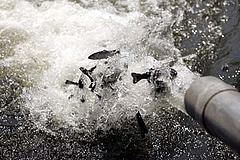forum
library
tutorial
contact

Complex Lives of the Steelhead
by Tom Curet, ID Dept of Fish & GameFlyFish News Service, November 1, 2006
|
the film forum library tutorial contact |

|
Complex Lives of the Steelheadby Tom Curet, ID Dept of Fish & GameFlyFish News Service, November 1, 2006 |
 You can tell by the multitudes of drift boats arriving in town every weekend - the steelhead are back in the Salmon River.
You can tell by the multitudes of drift boats arriving in town every weekend - the steelhead are back in the Salmon River.
So when did they get here? How long does it take them to get here from the ocean? What do they do all winter? The steelhead has one of the most fascinating and complex life histories of all sea-going (anadromous) fish that return to Idaho to spawn.
Steelhead began migrating from the ocean back to Idaho in July. Counting facilities on Columbia and Snake River dams allow biologists and anglers to track the movement and timing of these fish. A few will arrive in the upper Salmon River by late August or early September.
Radio tracking of moving fish shows that returning steelhead are capable of traveling up to 18 miles each day as they navigate their way through reservoir pools. In free flowing portions of the Snake River, they move up to sixteen miles per day.
In some years the water temperatures in the lower Snake River reservoirs can be high enough to inhibit adult movement into the Snake from the Columbia River. During those warm years, the arrival of the adult steelhead can be delayed until later in the fall.
Based on check station results over the past few weekends, steelhead are beginning to arrive in earnest. Fish will continue to arrive in the upper river corridor throughout the fall, and the upstream migration will continue until winter descends on the Salmon River country.
During most years, steelhead have been documented upstream as far as Challis before the onset of winter. Once winter grips the river, many of these fish will remain in the larger pools and deep run habitats in the Salmon River, waiting for spring to arrive at hatcheries or spawning areas.
After staging all winter, fish begin a final push upstream to their spawning grounds when winter relents. Many fish are enroute to either the Pahsimeroi or Sawtooth fish hatcheries or to one of the many Salmon River tributaries to spawn. This is the time we again see large numbers of anglers from throughout Idaho and surrounding states in their own migration to the river for a chance to catch one of these awesome fish.
Spring river conditions dictate how the spring fishing season progresses. Ice jams can dominate the river corridor throughout the winter. These ice jams, composed of hundreds of tons of broken, angular ice, can, at times, completely block and dam portions of the Salmon River. When the river is blocked, fish may not be able to move upstream in the spring, and, depending on the timing of the ice jam releases, this delay can affect the quality of fishing upstream of North Fork.
Rain or early season melting can also make the river conditions challenging for anglers.
The fish have really only one thing on their mind in spring - spawning. If they have been delayed because of cold weather ice jams or muddy water from snowmelt or rains, the fish can move quickly from their winter staging areas to their spawning locations. On such years, fishing can be slow and difficult. But if late winter or early spring conditions are mild, fishing can be good because river conditions remain very stable and clear for anglers.
The steelhead life history strategy is quite different from Pacific salmon, such as Chinook or sockeye, which all die after spawning. After spawning, some adult steelhead will begin migrating back down-river in an attempt to reach the ocean again.
Before dam construction on the lower Snake and Columbia rivers, some of these fish were able to make a repeat spawning run. But repeat spawning is a rare today.
The eggs from fish that successfully spawn in local streams will incubate throughout the spring, and the fry will typically emerge in June and begin foraging for food. Juvenile steelhead will remain in the upper Salmon River for one to five years before migrating back to the ocean to complete their grueling life cycle.
learn more on topics covered in the film
see the video
read the script
learn the songs
discussion forum
